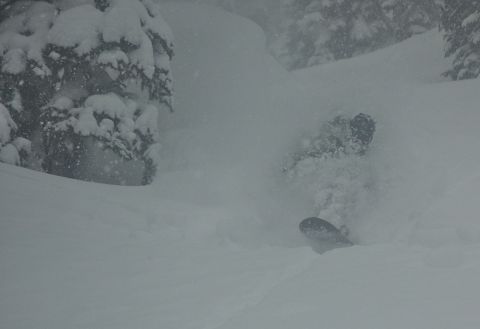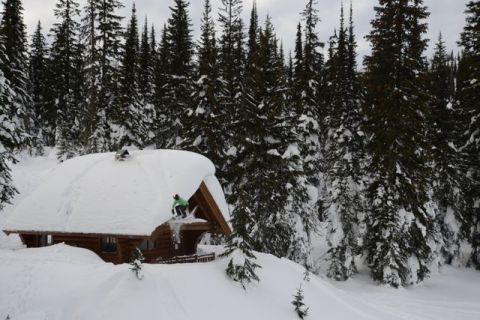Deep and Dicey- Soap Box Comp
Looking back over that last decade, ski touring has evolved leaps and bounds. Just 10 years ago backcountry enthusiasts were still skiing skinny planks, splitboarders were black sheep and the F1 was the industry standard beacon. While these aspects have certainly progressed, perhaps the grandest advancement has been our ability to attain information about mountain conditions and avalanche hazard. Industry professionals turn to the InfoEx, recreationalists upload CAA bulletins and today, even folks who spend more time in shopping malls than in mountains are aware of avalanche conditions because of trendy social media sites such as facebook, instagram and twitter. This is fantastic because nearly every skier, snowmobiler or snowshoer in the backcountry has a general idea of the hazard and can base decisions on their experience and risk tolerance. Over the last 2 weeks there has been more snowfall than the previous 3 months and more avalanche warning than the previous 3 years. I look on Facbook and friends across B.C. have uploaded pictures of huge fractures or remotely triggered size 3’s; there are videos of others cutting slides just outside ski area boundaries or triggering roadside convexities while passing on snowmobiles. I hear on the news that one snowmobiler has died on a mountain just outside the town where I grew up. I prey they’re not a friend. I then hear a tragic story about the organizer of split fest perishing in the south Rockies. A size 4 closes the Coquihalla and a “7day special public avalanche warning” is issued across BC. and still another fatality in Kootenay Pass just yesterday. This is an absolutely crazy time in our backcountry and I don’t think it has been this bad since 02/03 when sliding snow accounted for the loss of almost 30 lives in BC. All of this suggests that it is probably best to hit the lifts and wait until these layers consolidate before heading into the backcountry even if it takes a few weeks. Right.

White Beard Face Shot in low angle trees
Well, this is an easy decision for those folks who spend more time in shopping malls than in the mountains but for people whose lives depend on being in the mountains whether for work or just “feeling alive” this decision is not so simple. Like many of you, I had two birds sitting on my shoulder this past week. One bird chirping to stay home because these are potentially the worst avalanche conditions that have occurred in the last decade while the other bird chirping to go skiing because there is always safe skiing, even when mountains are falling down.

Things are deep: its a good time to find a safe spot and set up some pow pictures
Of course my 20’s kicked in and I went skiing all weekend. The powder was amazing and I had some of the best turns of the season. I realized quickly that the snowpack is just as terrible as everybody described. Every pit I dug made me pucker up and while skinning it felt as though the snowpack was hollow. I never felt at risk because I knew it was crazy dangerous out there and stuck to few guidelines that I tend to follow during times like this. There are obviously lots of other things and I would love to hear others tactics. Here are some things that I think about when the bird convinces me to leave the house.
1) Be Conservative: be happy that you are outside on your skies getting exercise and don’t have any greater expectations. Bring a better lunch, more tea and don’t feel the need to ski as much vertical as you normally would.
2) Pick a Good Team: this doesn’t necessarily mean the most experienced people or the best skiers but rather people who will have fun just being outside and won’t pressure you to “go just a little further”.
3) Know your ski area: High hazard is not a good time to explore new areas or new lines. Know a place that has good tree skiing that can be accessed without crossing through dangerous terrain. Know what is above you at all times.
4) Don’t increase your risk level: if the first run didn’t show any signs of instability don’t try something a little steeper, more open or more convexed. Do the same run, or something similar or even safer.
5) Pretend you are skiing alone: skiing alone makes you look at everything carefully because even little things can be lethal. Take this same approach; avoid all terrain traps, convexities and uncertainties. Don’t ski alone though.
6) Remind yourself that avalanches occur in trees or forests: just because you’re in the trees doesn’t make things safe. You have to consider all other aspects too.
7) Don’t wait for your first sign of instability to turn around: Know that its unstable and don’t wait for that first big “whoomph.” Stop well before you normally would.
8) Practice Your Skills: high hazard is a great time to get rid of those cob webs: Do searches, scenarios and go through your avy gear so when things stabilize your on you’re A-game.

If conditions prohibit you from venturing far, there is always something to ride
In the late 90’s when Rogers Pass was starting get busier, a respectable guide told me that his favorite time to ski the Pass was during high hazard because the snow was typically good and the crowds were less. I thought he was crazy but I’m sure he skied safely everyday this past week. With that said, it is as bad out there as I have ever witnessed. I have a feeling these conditions are going to last for while and maybe even get worst. Please be safe people. Sacrificing a life of powder turns for one good run is not worth it. Even though my last post mentioned that snow will not be around for ever, be optimistic. There are many ski days ahead.
Let it Snow







